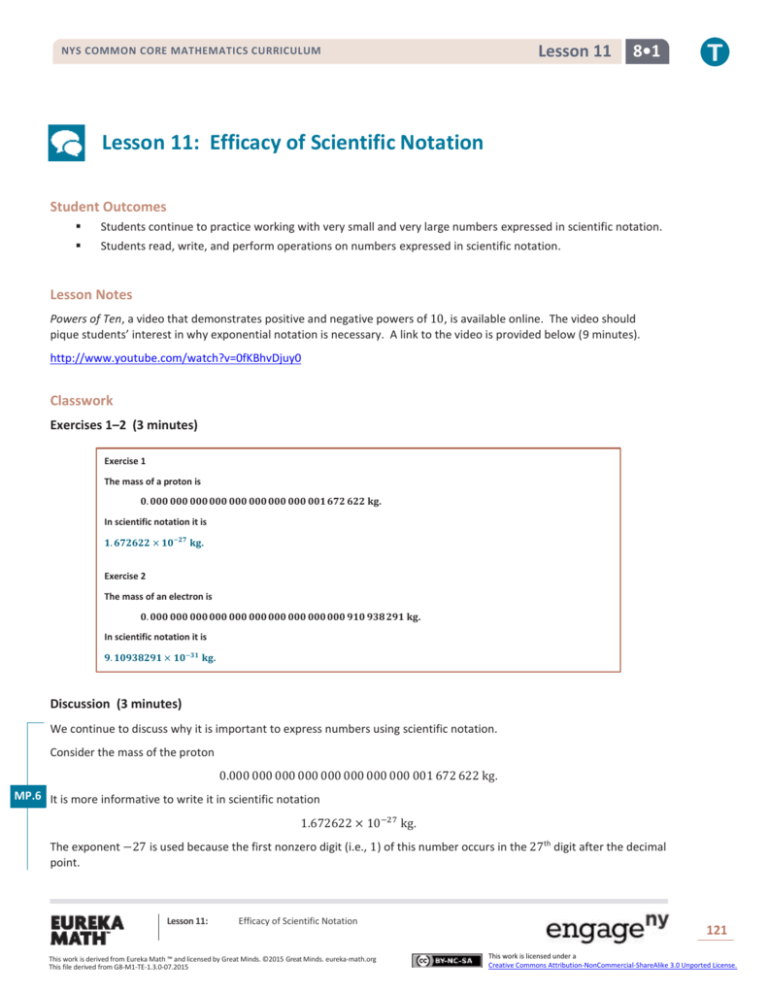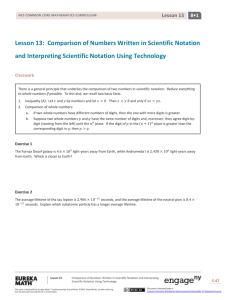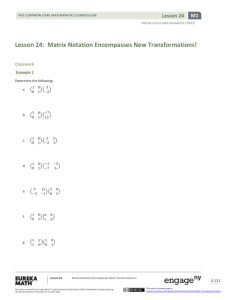Lesson 11: Efficacy of Scientific Notation
advertisement

Lesson 11 NYS COMMON CORE MATHEMATICS CURRICULUM 8•1 Lesson 11: Efficacy of Scientific Notation Student Outcomes Students continue to practice working with very small and very large numbers expressed in scientific notation. Students read, write, and perform operations on numbers expressed in scientific notation. Lesson Notes Powers of Ten, a video that demonstrates positive and negative powers of 10, is available online. The video should pique students’ interest in why exponential notation is necessary. A link to the video is provided below (9 minutes). http://www.youtube.com/watch?v=0fKBhvDjuy0 Classwork Exercises 1–2 (3 minutes) Exercise 1 The mass of a proton is 𝟎. 𝟎𝟎𝟎 𝟎𝟎𝟎 𝟎𝟎𝟎 𝟎𝟎𝟎 𝟎𝟎𝟎 𝟎𝟎𝟎 𝟎𝟎𝟎 𝟎𝟎𝟎 𝟎𝟎𝟏 𝟔𝟕𝟐 𝟔𝟐𝟐 𝐤𝐠. In scientific notation it is 𝟏. 𝟔𝟕𝟐𝟔𝟐𝟐 × 𝟏𝟎−𝟐𝟕 𝐤𝐠. Exercise 2 The mass of an electron is 𝟎. 𝟎𝟎𝟎 𝟎𝟎𝟎 𝟎𝟎𝟎 𝟎𝟎𝟎 𝟎𝟎𝟎 𝟎𝟎𝟎 𝟎𝟎𝟎 𝟎𝟎𝟎 𝟎𝟎𝟎 𝟎𝟎𝟎 𝟗𝟏𝟎 𝟗𝟑𝟖 𝟐𝟗𝟏 𝐤𝐠. In scientific notation it is 𝟗. 𝟏𝟎𝟗𝟑𝟖𝟐𝟗𝟏 × 𝟏𝟎−𝟑𝟏 𝐤𝐠. Discussion (3 minutes) We continue to discuss why it is important to express numbers using scientific notation. Consider the mass of the proton 0.000 000 000 000 000 000 000 000 001 672 622 kg. MP.6 It is more informative to write it in scientific notation 1.672622 × 10−27 kg. The exponent −27 is used because the first nonzero digit (i.e., 1) of this number occurs in the 27th digit after the decimal point. Lesson 11: Efficacy of Scientific Notation This work is derived from Eureka Math ™ and licensed by Great Minds. ©2015 Great Minds. eureka-math.org This file derived from G8-M1-TE-1.3.0-07.2015 121 This work is licensed under a Creative Commons Attribution-NonCommercial-ShareAlike 3.0 Unported License. Lesson 11 NYS COMMON CORE MATHEMATICS CURRICULUM 8•1 Similarly, the mass of the electron is 0.000 000 000 000 000 000 000 000 000 000 910 938 291 kg. Scaffolding: MP.6 It is much easier to read this number in scientific notation 9.10938291 × 10−31 kg. In this case, the exponent −31 is used because the first nonzero digit (i.e., 9) of this number occurs in the 31st digit to the right of the decimal point. Exercise 3 (3 minutes) Before students write the ratio that compares the mass of a proton to the mass of an electron, ask them whether they would rather write the ratio in standard (i.e., decimal) or scientific notation. If necessary, help them understand why scientific notation is more advantageous. Exercise 3 Some time should be spent making sense of these statements with students. This can be accomplished by, for example, providing a series of simpler numbers (e.g., 0.1, 0.01, 0.001) and demonstrating that when they are expressed in exponential notation, 10−1 , 10−2 , 10−3 , that the exponent tells that the first nonzero digit occurs in the first, second, and third digit to the right of the decimal point, respectively. Write the ratio that compares the mass of a proton to the mass of an electron. Ratio: (𝟏. 𝟔𝟕𝟐𝟔𝟐𝟐 × 𝟏𝟎−𝟐𝟕 ) ∶ (𝟗. 𝟏𝟎𝟗𝟑𝟖𝟐𝟗𝟏 × 𝟏𝟎−𝟑𝟏 ) Discussion (20 minutes) This discussion includes Example 1, Exercise 4, and Example 2. Example 1 The advantage of the scientific notation becomes even more pronounced when we have to compute how many times heavier a proton is than an electron. Instead of writing the value of the ratio, 𝑟, as 𝑟= 0.000 000 000 000 000 000 000 000 001 672 622 0.000 000 000 000 000 000 000 000 000 000 910 938 291 we express it as 𝑟= Should we eliminate the power of 10 in the numerator or denominator? Explain. MP.2 1.672622 × 10−27 . 9.10938291 × 10−31 Scaffolding: Using the theorem on generalized equivalent fractions, we can eliminate the negative power of 10 in the numerator and denominator to see what we are doing more clearly. Anticipating that 10−31 × 1031 = 1, we can multiply the numerator and denominator of the (complex) fraction by 1031 Lesson 11: Efficacy of Scientific Notation This work is derived from Eureka Math ™ and licensed by Great Minds. ©2015 Great Minds. eureka-math.org This file derived from G8-M1-TE-1.3.0-07.2015 When students ask why we eliminated the negative power of 10 in the denominator (instead of the numerator), explain that positive powers of 10 are easier to interpret. 122 This work is licensed under a Creative Commons Attribution-NonCommercial-ShareAlike 3.0 Unported License. NYS COMMON CORE MATHEMATICS CURRICULUM 𝑟= Lesson 11 8•1 1.672622 × 10−27 1031 × . 9.10938291 × 10−31 1031 Using the first law of exponents (10) presented in Lesson 5, we get 𝑟= 1.672622 × 104 1.672622 = × 104 . 9.10938291 9.10938291 MP.2 Note that since we are using scientific notation, we can interpret an approximate value of 𝑟 right away. For example, we see 1.672622 1.7 17 1 ≈ = ≈ 9.10938291 9.1 91 5 1 so that 𝑟 is approximately × 10,000, which is 2,000. Thus, we expect a proton to be about two thousand times 5 heavier than an electron. Exercise 4 Students find a more precise answer for Example 1. Allow students to use a calculator to divide 1.672 622 by 9.109 382 91. When they finish, have students compare the approximate answer (2,000) to their more precise answer (1,836). Exercise 4 Compute how many times heavier a proton is than an electron (i.e., find the value of the ratio). Round your final answer to the nearest one. Let 𝒓 = the value of the ratio, then: 𝒓= = 𝟏. 𝟔𝟕𝟐𝟔𝟐𝟐 × 𝟏𝟎−𝟐𝟕 𝟗. 𝟏𝟎𝟗𝟑𝟖𝟐𝟗𝟏 × 𝟏𝟎−𝟑𝟏 𝟏. 𝟔𝟕𝟐𝟔𝟐𝟐 × 𝟏𝟎−𝟐𝟕 × 𝟏𝟎𝟑𝟏 𝟗. 𝟏𝟎𝟗𝟑𝟖𝟐𝟗𝟏 × 𝟏𝟎−𝟑𝟏 × 𝟏𝟎𝟑𝟏 𝟏. 𝟔𝟕𝟐𝟔𝟐𝟐 × 𝟏𝟎𝟒 𝟗. 𝟏𝟎𝟗𝟑𝟖𝟐𝟗𝟏 𝟏. 𝟔𝟕𝟐𝟔𝟐𝟐 = × 𝟏𝟎𝟒 𝟗. 𝟏𝟎𝟗𝟑𝟖𝟐𝟗𝟏 = 𝟏. 𝟔𝟕𝟐𝟔𝟐𝟐 × 𝟏𝟎𝟖 × 𝟏𝟎𝟒 𝟗. 𝟏𝟎𝟗𝟑𝟖𝟐𝟗𝟏 × 𝟏𝟎𝟖 𝟏𝟔𝟕, 𝟐𝟔𝟐, 𝟐𝟎𝟎 = × 𝟏𝟎𝟒 𝟗𝟏𝟎, 𝟗𝟑𝟖, 𝟐𝟗𝟏 = = 𝟎. 𝟏𝟖𝟑𝟔𝟏𝟓𝟐𝟗𝟏𝟔𝟕𝟓 × 𝟏𝟎𝟒 = 𝟏𝟖𝟑𝟔. 𝟏𝟓𝟐𝟗𝟏𝟔𝟕𝟓 ≈ 𝟏𝟖𝟑𝟔 Lesson 11: Efficacy of Scientific Notation This work is derived from Eureka Math ™ and licensed by Great Minds. ©2015 Great Minds. eureka-math.org This file derived from G8-M1-TE-1.3.0-07.2015 123 This work is licensed under a Creative Commons Attribution-NonCommercial-ShareAlike 3.0 Unported License. Lesson 11 NYS COMMON CORE MATHEMATICS CURRICULUM 8•1 Example 2 As of March 23, 2013, the U.S. national debt was $16,755,133,009,522 (rounded to the nearest dollar). According to the 2012 U.S. census, there are about 313,914,040 American citizens. What is each citizen’s approximate share of the debt? How precise should we make our answer? Do we want to know the exact amount, to the nearest dollar, or is a less precise answer alright? The most precise answer uses the exact numbers listed in the problem. The more the numbers are rounded, the precision of the answer decreases. We should aim for the most precise answer when necessary, but the following problem does not require it since we are finding the “approximate share of the debt.” Let’s round off the debt to the nearest billion (109 ). It is $16,755,000,000,000, which is 1.6755 × 1013 dollars. Let’s also round off the population to the nearest million (106 ), making it 314,000,000, which is 3.14 × 108 . Therefore, using the product formula and equation (13) from Lesson 5, we see that each citizen’s share of the debt, in dollars, is 1.6755 × 1013 1.6755 1013 = × 3.14 × 108 3.14 108 1.6755 = × 105 . 3.14 Once again, we note the advantages of computing numbers expressed in scientific notation. Immediately, we can approximate the answer, about half of 105 , or a hundred thousand dollars, (i.e., about $50,000), because 1.6755 1.7 17 1 ≈ = ≈ . 3.14 3.1 31 2 More precisely, with the help of a calculator, 1.6755 16755 = = 0.533598. . . ≈ 0.5336. 3.14 31410 Therefore, each citizen’s share of the U.S. national debt is about $53,360. Example 2 The U.S. national debt as of March 𝟐𝟑, 𝟐𝟎𝟏𝟑, rounded to the nearest dollar, is $𝟏𝟔, 𝟕𝟓𝟓, 𝟏𝟑𝟑, 𝟎𝟎𝟗, 𝟓𝟐𝟐. According to the 𝟐𝟎𝟏𝟐 U.S. census, there are about 𝟑𝟏𝟑, 𝟗𝟏𝟒, 𝟎𝟒𝟎 U.S. citizens. What is each citizen’s approximate share of the debt? 𝟏. 𝟔𝟕𝟓𝟓 × 𝟏𝟎𝟏𝟑 𝟏. 𝟔𝟕𝟓𝟓 𝟏𝟎𝟏𝟑 = × 𝟑. 𝟏𝟒 × 𝟏𝟎𝟖 𝟑. 𝟏𝟒 𝟏𝟎𝟖 𝟏. 𝟔𝟕𝟓𝟓 = × 𝟏𝟎𝟓 𝟑. 𝟏𝟒 = 𝟎. 𝟓𝟑𝟑𝟓𝟗𝟖. . .× 𝟏𝟎𝟓 ≈ 𝟎. 𝟓𝟑𝟑𝟔 × 𝟏𝟎𝟓 = 𝟓𝟑𝟑𝟔𝟎 Each U.S. citizen’s share of the national debt is about $𝟓𝟑, 𝟑𝟔𝟎. Lesson 11: Efficacy of Scientific Notation This work is derived from Eureka Math ™ and licensed by Great Minds. ©2015 Great Minds. eureka-math.org This file derived from G8-M1-TE-1.3.0-07.2015 124 This work is licensed under a Creative Commons Attribution-NonCommercial-ShareAlike 3.0 Unported License. Lesson 11 NYS COMMON CORE MATHEMATICS CURRICULUM 8•1 Exercises 5–6 (8 minutes) Students work on Exercises 5 and 6 independently. Exercise 5 The geographic area of California is 𝟏𝟔𝟑, 𝟔𝟗𝟔 𝐬𝐪. 𝐦𝐢., and the geographic area of the U.S. is 𝟑, 𝟕𝟗𝟒, 𝟏𝟎𝟏 𝐬𝐪. 𝐦𝐢. Let’s round off these figures to 𝟏. 𝟔𝟑𝟕 × 𝟏𝟎𝟓 and 𝟑. 𝟕𝟗𝟒 × 𝟏𝟎𝟔 . In terms of area, roughly estimate how many Californias would make up one U.S. Then compute the answer to the nearest ones. 𝟑. 𝟕𝟗𝟒 × 𝟏𝟎𝟔 𝟑. 𝟕𝟗𝟒 𝟏𝟎𝟔 = × 𝟏. 𝟔𝟑𝟕 × 𝟏𝟎𝟓 𝟏. 𝟔𝟑𝟕 𝟏𝟎𝟓 𝟑. 𝟕𝟗𝟒 = × 𝟏𝟎 𝟏. 𝟔𝟑𝟕 = 𝟐. 𝟑𝟏𝟕𝟔. . .× 𝟏𝟎 ≈ 𝟐. 𝟑𝟏𝟖 × 𝟏𝟎 = 𝟐𝟑. 𝟏𝟖 It would take about 𝟐𝟑 Californias to make up one U.S. Exercise 6 The average distance from Earth to the moon is about 𝟑. 𝟖𝟒 × 𝟏𝟎𝟓 𝐤𝐦, and the distance from Earth to Mars is approximately 𝟗. 𝟐𝟒 × 𝟏𝟎𝟕 𝐤𝐦 in year 𝟐𝟎𝟏𝟒. On this simplistic level, how much farther is traveling from Earth to Mars than from Earth to the moon? 𝟗. 𝟐𝟒 × 𝟏𝟎𝟕 − 𝟑. 𝟖𝟒 × 𝟏𝟎𝟓 = 𝟗𝟐𝟒 × 𝟏𝟎𝟓 − 𝟑. 𝟖𝟒 × 𝟏𝟎𝟓 = (𝟗𝟐𝟒 − 𝟑. 𝟖𝟒) × 𝟏𝟎𝟓 = 𝟗𝟐𝟎. 𝟏𝟔 × 𝟏𝟎𝟓 = 𝟗𝟐 𝟎𝟏𝟔 𝟎𝟎𝟎 It is 𝟗𝟐, 𝟎𝟏𝟔, 𝟎𝟎𝟎 𝐤𝐦 further to travel from Earth to Mars than from Earth to the moon. Closing (3 minutes) Summarize, or have students summarize, the lesson. We can read, write, and operate with numbers expressed in scientific notation. Exit Ticket (5 minutes) Lesson 11: Efficacy of Scientific Notation This work is derived from Eureka Math ™ and licensed by Great Minds. ©2015 Great Minds. eureka-math.org This file derived from G8-M1-TE-1.3.0-07.2015 125 This work is licensed under a Creative Commons Attribution-NonCommercial-ShareAlike 3.0 Unported License. Lesson 11 NYS COMMON CORE MATHEMATICS CURRICULUM Name 8•1 Date Lesson 11: Efficacy of the Scientific Notation Exit Ticket 1. Two of the largest mammals on earth are the blue whale and the African elephant. An adult male blue whale weighs about 170 tonnes or long tons. (1 tonne = 1000 kg) Show that the weight of an adult blue whale is 1.7 × 105 kg. 2. An adult male African elephant weighs about 9.07 × 103 kg. Compute how many times heavier an adult male blue whale is than an adult male African elephant (i.e., find the value of the ratio). Round your final answer to the nearest one. Lesson 11: Efficacy of Scientific Notation This work is derived from Eureka Math ™ and licensed by Great Minds. ©2015 Great Minds. eureka-math.org This file derived from G8-M1-TE-1.3.0-07.2015 126 This work is licensed under a Creative Commons Attribution-NonCommercial-ShareAlike 3.0 Unported License. Lesson 11 NYS COMMON CORE MATHEMATICS CURRICULUM 8•1 Exit Ticket Sample Solutions 1. Two of the largest mammals on earth are the blue whale and the elephant. An adult male blue whale weighs about 𝟏𝟕𝟎 tonnes or long tons. (𝟏 tonne = 𝟏𝟎𝟎𝟎 𝐤𝐠) Show that the weight of an adult blue whale is 𝟏. 𝟕 × 𝟏𝟎𝟓 𝐤𝐠. Let 𝒙 (or any other symbol) represent the number of kilograms an adult blue whale weighs. 𝟏𝟕𝟎 × 𝟏𝟎𝟎𝟎 = 𝒙 𝟏. 𝟕 × 𝟏𝟎𝟓 = 𝒙 2. An adult male elephant weighs about 𝟗. 𝟎𝟕 × 𝟏𝟎𝟑 𝐤𝐠. Compute how many times heavier an adult male blue whale is than an adult male elephant (i.e., find the value of the ratio). Round your final answer to the nearest one. Let 𝒓 be the value of the ratio. 𝟏. 𝟕 × 𝟏𝟎𝟓 𝟗. 𝟎𝟕 × 𝟏𝟎𝟑 𝟏. 𝟕 = × 𝟏𝟎𝟐 𝟗. 𝟎𝟕 = 𝟎. 𝟏𝟖𝟕𝟒𝟑 × 𝟏𝟎𝟐 𝒓= = 𝟏𝟖. 𝟕𝟒𝟑 ≈ 𝟏𝟗 The blue whale is 𝟏𝟗 times heavier than the elephant. Problem Set Sample Solutions 1. There are approximately 𝟕. 𝟓 × 𝟏𝟎𝟏𝟖 grains of sand on Earth. There are approximately 𝟕 × 𝟏𝟎𝟐𝟕 atoms in an average human body. Are there more grains of sand on Earth or atoms in an average human body? How do you know? There are more atoms in the average human body. When comparing the order of magnitude of each number, 𝟐𝟕 > 𝟏𝟖; therefore, 𝟕 × 𝟏𝟎𝟐𝟕 > 𝟕. 𝟓 × 𝟏𝟎𝟏𝟖 . 2. About how many times more atoms are in a human body compared to grains of sand on Earth? 𝟕 × 𝟏𝟎𝟐𝟕 𝟕 𝟏𝟎𝟐𝟕 = × 𝟏𝟖 𝟏𝟖 𝟕. 𝟓 × 𝟏𝟎 𝟕. 𝟓 𝟏𝟎 ≈ 𝟏 × 𝟏𝟎𝟐𝟕−𝟏𝟖 ≈ 𝟏 × 𝟏𝟎𝟗 ≈ 𝟏𝟎𝟗 There are about 𝟏, 𝟎𝟎𝟎, 𝟎𝟎𝟎, 𝟎𝟎𝟎 times more atoms in the human body compared to grains of sand on Earth. Lesson 11: Efficacy of Scientific Notation This work is derived from Eureka Math ™ and licensed by Great Minds. ©2015 Great Minds. eureka-math.org This file derived from G8-M1-TE-1.3.0-07.2015 127 This work is licensed under a Creative Commons Attribution-NonCommercial-ShareAlike 3.0 Unported License. Lesson 11 NYS COMMON CORE MATHEMATICS CURRICULUM 3. 8•1 Suppose the geographic areas of California and the U.S. are 𝟏. 𝟔𝟑𝟕 × 𝟏𝟎𝟓 and 𝟑. 𝟕𝟗𝟒 × 𝟏𝟎𝟔 𝐬𝐪. 𝐦𝐢., respectively. California’s population (as of 𝟐𝟎𝟏𝟐) is approximately 𝟑. 𝟖𝟎𝟒 × 𝟏𝟎𝟕 people. If population were proportional to area, what would be the U.S. population? We already know from Exercise 5 that it would take about 𝟐𝟑 Californias to make up one U.S. Then the population of the U.S. would be 𝟐𝟑 times the population of California, which is 𝟐𝟑 × 𝟑. 𝟖𝟎𝟒 × 𝟏𝟎𝟕 = 𝟖𝟕. 𝟒𝟗𝟐 × 𝟏𝟎𝟕 = 𝟖. 𝟕𝟒𝟗𝟐 × 𝟏𝟎𝟖 = 𝟖𝟕𝟒, 𝟗𝟐𝟎, 𝟎𝟎𝟎. 4. The actual population of the U.S. (as of 𝟐𝟎𝟏𝟐) is approximately 𝟑. 𝟏𝟒 × 𝟏𝟎𝟖 . How does the population density of California (i.e., the number of people per square mile) compare with the population density of the U.S.? Population density of California per square mile: 𝟑. 𝟖𝟎𝟒 × 𝟏𝟎𝟕 𝟑. 𝟖𝟎𝟒 𝟏𝟎𝟕 = × 𝟏. 𝟔𝟑𝟕 × 𝟏𝟎𝟓 𝟏. 𝟔𝟑𝟕 𝟏𝟎𝟓 = 𝟐. 𝟑𝟐𝟑𝟕𝟔. . .× 𝟏𝟎𝟐 ≈ 𝟐. 𝟑𝟐 × 𝟏𝟎𝟐 = 𝟐𝟑𝟐 Population density of the U.S. per square mile: 𝟑. 𝟏𝟒 × 𝟏𝟎𝟖 𝟑. 𝟏𝟒 𝟏𝟎𝟖 = × 𝟑. 𝟕𝟗𝟒 × 𝟏𝟎𝟔 𝟑. 𝟕𝟗𝟒 𝟏𝟎𝟔 = 𝟎. 𝟖𝟐𝟕𝟔. . .× 𝟏𝟎𝟐 ≈ 𝟎. 𝟖𝟑 × 𝟏𝟎𝟐 = 𝟖𝟑 Population density of California compared to the population density of the U.S.: 𝟐𝟑𝟐 = 𝟐. 𝟕𝟗𝟓𝟏 … 𝟖𝟑 ≈ 𝟐. 𝟖 California is about 𝟑 times as dense as the U.S. in terms of population. Lesson 11: Efficacy of Scientific Notation This work is derived from Eureka Math ™ and licensed by Great Minds. ©2015 Great Minds. eureka-math.org This file derived from G8-M1-TE-1.3.0-07.2015 128 This work is licensed under a Creative Commons Attribution-NonCommercial-ShareAlike 3.0 Unported License.








